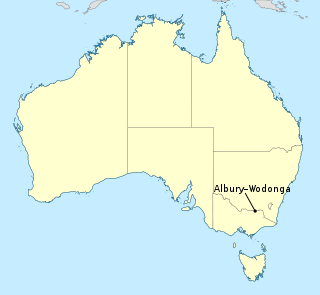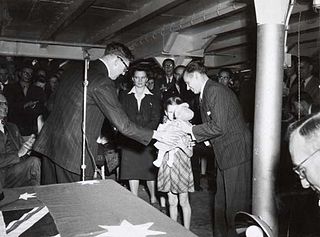
Albury–Wodonga is the broad settlement incorporating the twin Australian cities of Albury and Wodonga, which are separated geographically by the Murray River and politically by a state border: Albury on the north of the river is part of New South Wales, while Wodonga on the south bank is in Victoria.

Albury is a major regional city that is located in the Murray region of New South Wales, Australia. It is part of the twin city of Albury-Wodonga and is located on the Hume Highway and the northern side of the Murray River. Albury is the seat of local government for the council area which also bears the city's name – the City of Albury. It is on the Victoria–New South Wales border.

Wodonga is a city on the Victorian side of the border with New South Wales, 324 kilometres (201 mi) north-east of Melbourne, Australia. It is part of the twin city of Albury-Wodonga and is located wholly within the boundaries of the City of Wodonga LGA and is separated from its twin city in New South Wales, Albury, by the Murray River. As of 2021 Wodonga and its suburbs have a population of 38,949 and combined with Albury, the two cities form the urban area Albury-Wodonga with a population of 97,793. There are multiple suburbs of Wodonga including Bandiana, Baranduda, Barnawartha, Bonegilla, Ebden, Huon Creek, Killara, Leneva and Staghorn.

The Scheyville National Park is a protected national park that is located in the northwestern suburbs of Sydney in New South Wales, in eastern Australia. The 920-hectare (2,300-acre) national park is situated approximately 40 kilometres (25 mi) northwest of the Sydney central business district, northeast of Windsor, near the settlement of Scheyville. Longneck Lagoon lies in the northern section of the park. It was added to the New South Wales State Heritage Register on 9 April 2010.

The City of Wodonga is a local government area in the Hume region of Victoria, Australia, located in the north-east part of the state. It covers an area of 433 square kilometres (167 sq mi) and in August 2021, had a population of 43,253.

Ten Pound Poms were British citizens who migrated to Australia and New Zealand after the Second World War. The Government of Australia initiated the Assisted Passage Migration Scheme in 1945, and the Government of New Zealand initiated a similar scheme in 1947. The Australian government arranged for assisted passage to Australia on chartered ships and aircraft.

Uranquinty is a small town approximately 15 kilometres (9 mi) south of Wagga Wagga, in the Riverina region of New South Wales, Australia. The population of the town, often referred to as "Quinty", is 909.

Post-war immigration to Australia deals with migration to Australia in the decades immediately following World War II, and in particular refers to the predominantly European wave of immigration which occurred between 1945 and the end of the White Australia policy in 1973. In the immediate aftermath of World War II, Ben Chifley, Prime Minister of Australia (1945–1949), established the federal Department of Immigration to administer a large-scale immigration program. Chifley commissioned a report on the subject which found that Australia was in urgent need of a larger population for the purposes of defence and development and it recommended a 1% annual increase in population through increased immigration.

Jindera is a small town in the South West Slopes section of the Riverina region of New South Wales, Australia. The town is situated in the Greater Hume Shire local government area, 15 kilometres (9.3 mi) north of the regional centre of Albury. At the 2016 census, Jindera had a population of 2,222 residents.

Ukrainian Australians refers to Australian citizens of Ukrainian descent, or Ukraine-born people who emigrated to Australia. They are an ethnic minority in Australia, numbering about 38,000 people according to the 2011 Census. Currently, the main concentrations of Ukrainians are located in the cities of Sydney and Melbourne.

Greta Army Camp was an Australian Army camp built in 1939 near Greta, New South Wales, Australia. It was used for training soldiers of the Second Australian Imperial Force (2AIF) during World War II. After World War II, the camp was converted into a migrant camp. The Australian army sold the site at auction in 1980.

Leonid Denysenko was a Ukrainian Australian artist living in Sydney, Australia. He is notable for the introduction of the graphic art technique of "literography". He is the only surviving founding member of the Ukrainian Artists Society of Australia.
Bonegilla was a railway station located in the town of Bonegilla, on the Cudgewa railway line in Victoria, Australia.

Bonegilla is a bounded rural locality of the City of Wodonga local government area in north-east Victoria, Australia, ten km (6 mi) east of Wodonga, and around 300 km (190 mi) north-east of Melbourne. At the 2021 census, Bonegilla and the surrounding area had a population of 610.
Latchford Barracks is an Australian Army base in Bonegilla, located about 8 km (5 mi) to the east of Wodonga. It is named after Colonel E.W. Latchford, MBE, MC (1889–1962). The barracks is host to the Army Logistic Training Centre. The Bonegilla Migrant Reception and Training Centre was located at the barracks, prior to the barracks being reused for military purposes.
Finnish Australians are Australian citizens of Finnish ancestry or Finland-born people who reside in Australia. According to Finnish estimates, there are approximately 30,000 Australians of Finnish ancestry, and about 7,500 Finland-born Finns residing in Australia.

Commonwealth Acetate of Lime Factory is a heritage-listed factory at 82 Colmslie Road, Morningside, City of Brisbane, Queensland, Australia. It is also known as Colmslie Migrant Hostel, Fairmile Naval Base, Hans Continental Smallgoods Factory, and HMAS Moreton, Colmslie. It was added to the Queensland Heritage Register on 7 December 2007.

The Benalla Migrant Camp, formally known as the Benalla Holding Centre and the Benalla Migrant Accommodation Centre, was one of 23 similar camps established by the Australian government to provide temporary housing for non-British new arrivals in post-World War II Australia. Opened in Benalla in 1949, it housed migrant families until 1967, when the number of residents had diminished sufficiently for the camp to close. By that time, over 60,000 people, mainly of Polish, Latvian, Lithuanian, German, and Estonian origins, as well as other nationalities, had been accommodated there. After decades of neglect, the site was finally recognised and state heritage listed in 2016.
Balgownie Migrant Workers Hostel is a heritage-listed former migrant hostel at Squires Way, Fairy Meadow, in the Illawarra region of New South Wales, Australia. It was built from 1950 to 1951 by Concrete Constructions Pty Ltd. The surviving remnants of the hostel are Huts 201, 204 and 210. It is also known as the Fairy Meadow Migrant Hostel. The site is now used for student accommodation as part of the University of Wollongong's Campus East. It was added to the New South Wales State Heritage Register on 28 August 2009.


















